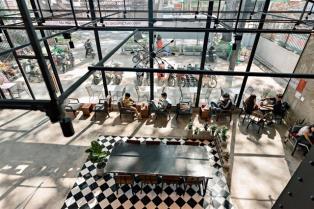The volume of goods transported through southern ports has been rising by an average of 20 per cent a year in recent years, according to a report by Vietcombank Securities Company (VCBS).

The volume of goods transported through southern ports has been rising by an average of 20 per cent a year in recent years, according to a report by Vietcombank Securities Company (VCBS).
The rate in the north has been 13.2 per cent.
Data from the General Statistics Office shows that in the first half of this year seaports in southern provinces like Ba Ria - Vung Tau, Tien Giang and An Giang achieved high growth rates.
VCBS analysts said there are several reasons for this.
They shared some common advantages with the rest of the country like the high growth in Viet Nam’s exports and imports thanks to free trade agreements it has signed with several countries that are starting to take effect.
Market Research Company Fitch Solutions has forecast Viet Nam’s trade to grow at an annual rate of 11 per cent between 2021 and 2024.
The Government’s pro-active investment in the logistics infrastructure in recent years has helped attract supply chains from many countries, helping increase imports and exports that pass through the country’s ports.
They said in the past huge volumes of exports from the south to China were transported to northern ports by sea and then by road to the Chinese border.
But recently the Chinese government has tightly controlled border trade with other countries, and as a result a majority of goods from the south are now transported directly by sea to China, significantly decreasing the volume of freight handled by northern ports like Hai Phong, they pointed out.
However, the most important reason for the southern seaport system to do well is the development of deep-water facilities at some locations, particularly Ba Ria - Vung Tau Province.
Industry insiders concurred with the analysts, saying deep-water ports are increasingly preferred around the world since they could handle large vessels like large container ships and bulk carriers.
Meanwhile, according to the SSI Securities experts, the increasing demand for cargo transportation has seen larger and larger container vessels being built, which only deep-water ports can handle.
Investments
Realising the trend, some major logistics companies in the south have stepped up investment into deep-water ports.
Gemadept is one such. The company has entered into a joint venture with French container shipping giant CMA-Terminals to build the Gemalink Port, Viet Nam’s deepest and largest to date.
The joint venture, Terminal Link Cai Mep Terminal JSC, has a total capital of $520 million with the first phase of construction costing $330 million.
The port spreads over an area of 72ha and has an annual capacity of 2.4 million twenty-foot equivalent units (TEU). It can handle the world’s largest ships.
A Gemadept executive said as soon as the first phase was completed and the port began operation in January this year, it helped double the company’s container loading capacity.
The port, situated in the Cai Mep -Thi Vai Complex, is equipped with the most modern European facilities. It has dedicated berths for feeders and barges to optimise productivity and avoid the congestion that plagues many ports around the world.
The VCBS experts estimated it could generate enough turnover for the company to break even in its very first year.
Gemalink has become the pride of Viet Nam as one of the 19 largest ports in the world and being capable of handling vessels of up to 200,000 DWT.
Gemalink is also expected to become one of the most important transshipment hubs in the Asia-Pacific region.
Gemalink is not Gemadept’s first deep-water port.
In 2018 it completed the first stage of the Nam Dinh Vu Container Terminal in the Nam Dinh Vu Industrial Park in the northern city of Hai Phong and put it into operation.
It was the company’s seventh port and second deep-water port, and can berth vessels of up to 40,000 tonnes.
But its first deep-water port was the Tan Cang - Cai Mep International Container Terminal at the Cap Mep -Thi Vai complex, which for eight years remained the largest deep-water terminal in the country.
The Cai Mep -Thi Vai complex is in Ba Ria - Vung Tau Province, around 80km south of HCM City. It contains a cluster of deepwater ports with a combined length of over 20km that handle over 30 per cent of the country’s exports by containers.
According to the Vietnam Seaports Association, in the first five months of 2021 the total throughput volume passing through Cai Mep - Thi Vai was 2.3 million TEUs, a 47 per cent increase from the same period last year.
It has the title of fastest-growing seaport in the world with an average annual growth rate of 22 per cent.
Development
With a coastline stretching over 3,000km, Viet Nam has a maritime and inland waterway transport system that plays an important role in the country’s socio-economic development.
Every year its ports handle 90 per cent of imports and exports.
As of April this year there were 286 ports in the country with a total wharf length of 96km, more than 4.5 times the figure 20 years ago.
They handled total cargo of more than 692 million tonnes, 8.4 times the volume in 2000.
The volume of containers they handled increased by more than 15 times in the 2001-2021 period.
Recognising this great potential of deep-water ports as well as the country’s natural advantages, the Government has approved a new master plan for the development of the seaport network with top priority given to deep-water ports.
The master plan will take advantage of the favourable geographical and natural conditions and technological advancements to ensure comprehensive development of ports.
It will focus on investment in key ports, particularly deep-water facilities, to make them the pillars of the maritime economy and promote the development of the logistics industry.
Analysts said it is important that the Vietnam Maritime Administration frequently assesses the situation to amend the development orientations in a timely manner in line with evolving needs.
They said special attention should be paid to developing ports in the Mekong Delta, which has an abundance of agricultural products for export but lacks a well-developed port system.
A deep-water port would, together with Can Tho Airport, promote the region’s economic development, they added. — VNS





